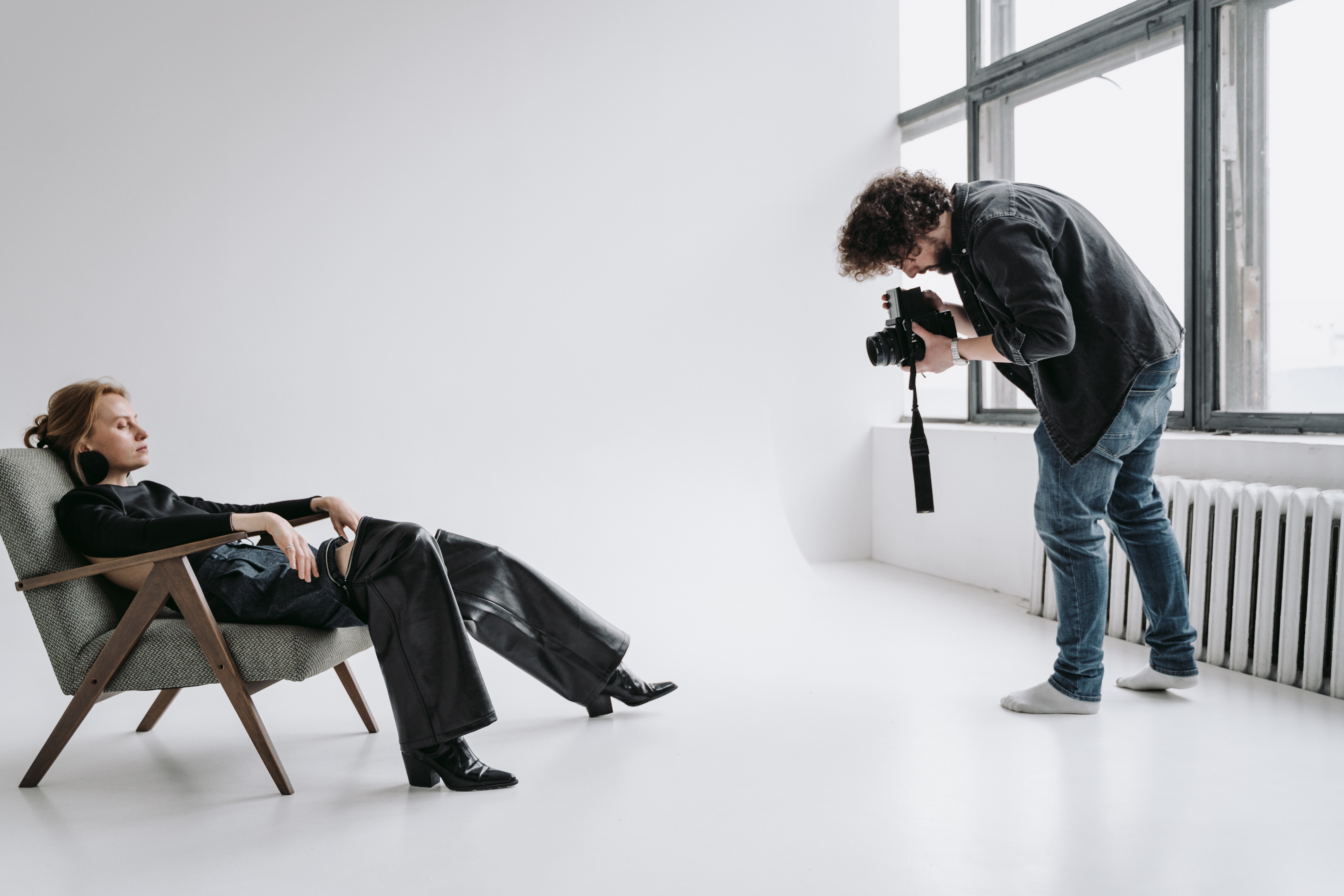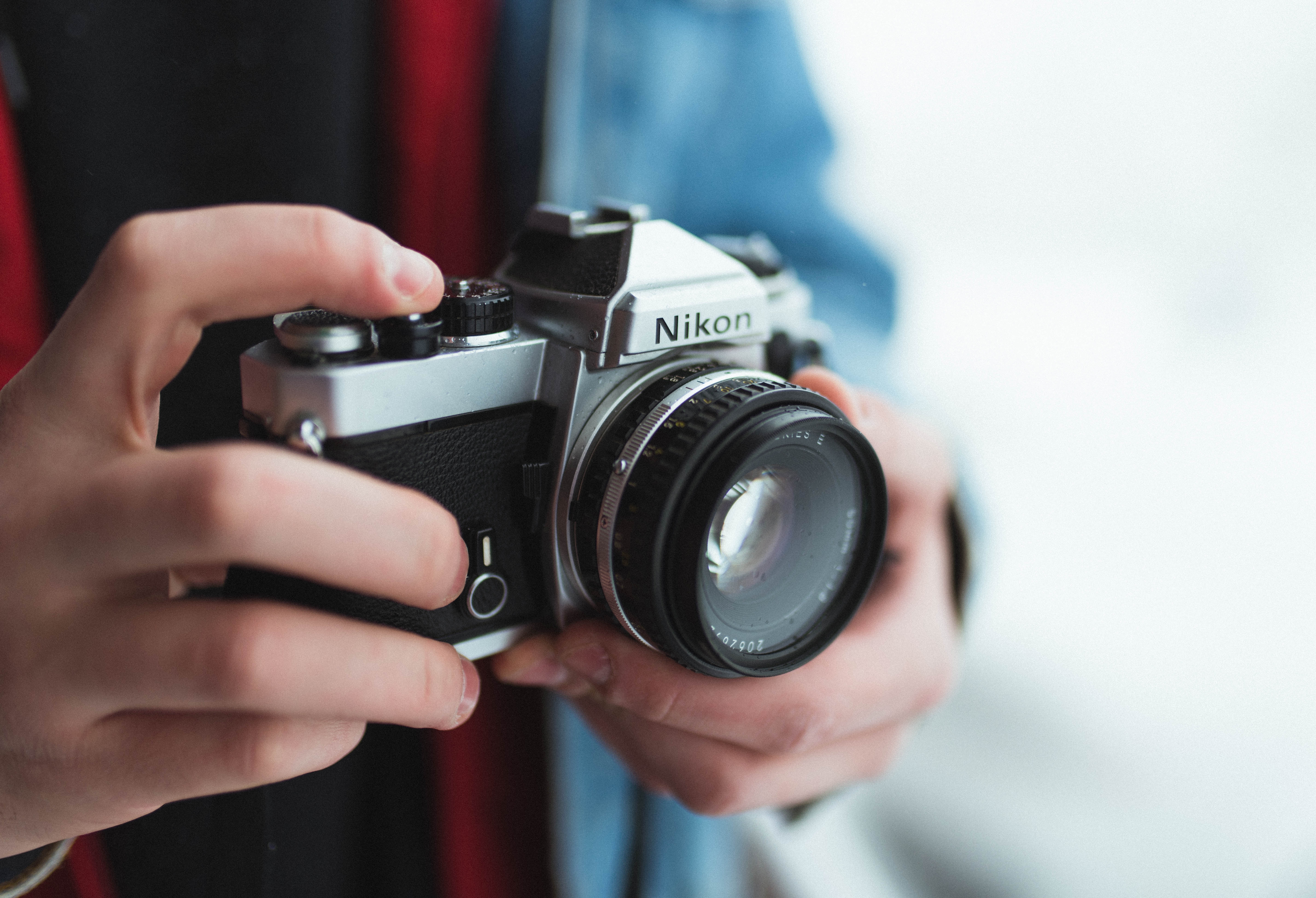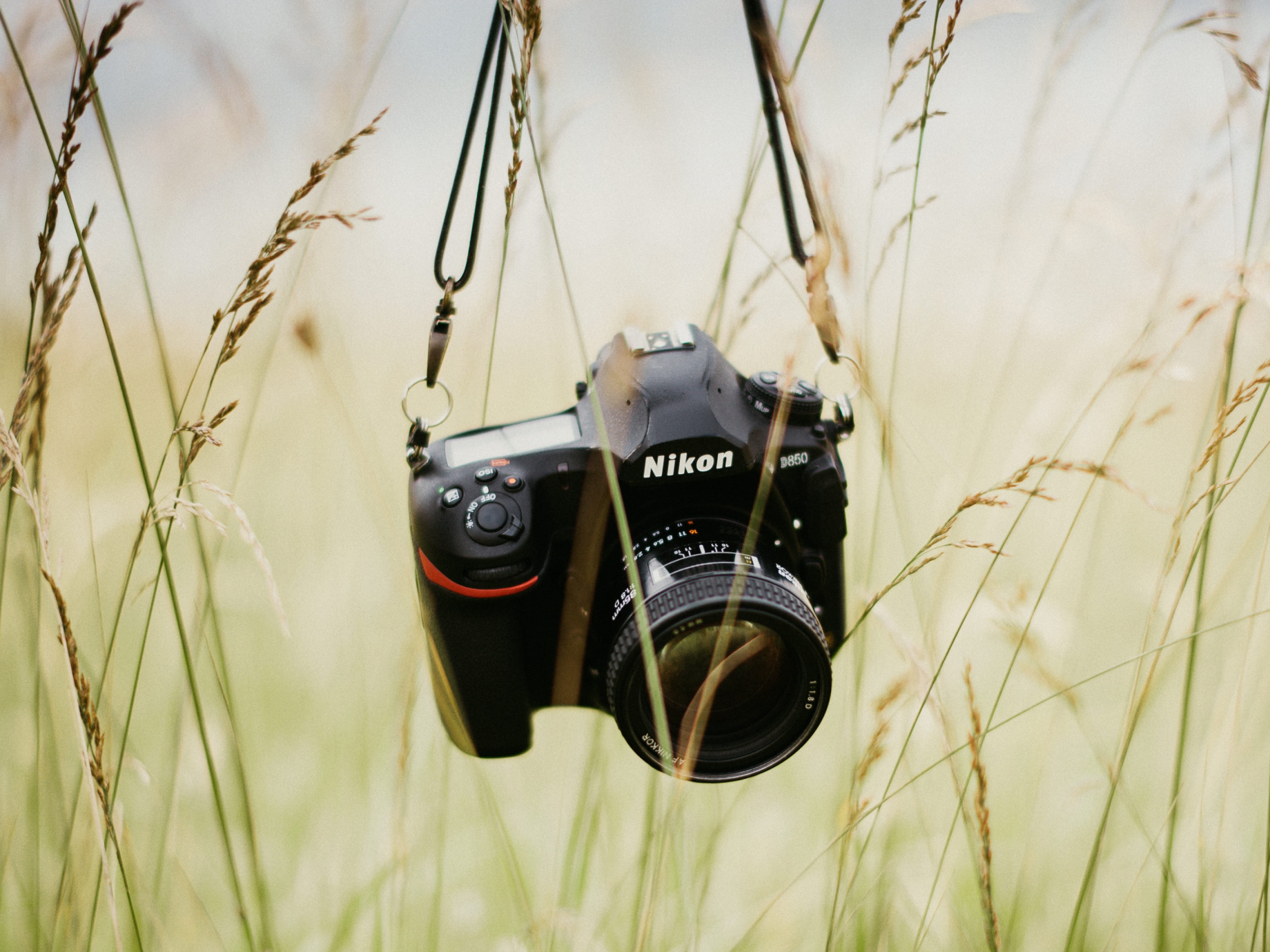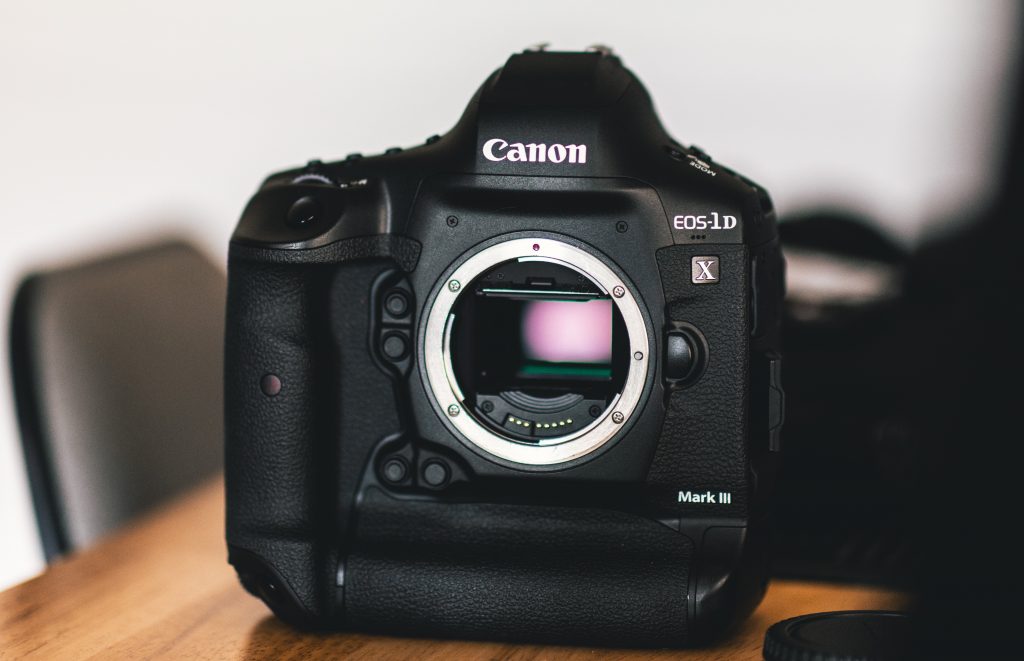
In the 2nd half of the 20th century Nikon became one of the best-known and most trusted makers of reliable pro and semi-pro cameras and lenses. Nikon’s extensive system proved popular as among photojournalists. Photographers working for big-name outlets and publications like the Associated Press and National Geographic found Nikons to be dependable go-to solutions for challenging assignments. As photographic technology has changed and we moved into the digital era, Nikon has remained at the forefront of this innovation and refinement. Nikon owners have learned they’ll get the features, controls & ergonomics they need, in well thought out, smartly implemented, and pro tested designs. Nikon also undertakes considerable efforts to maximize backwards lens compatibility as much as practical, so a user’s investment in the system can continue for many years.
If you’re shopping for a new Nikon camera body, you have many options. Mirrorless cameras, DLSRs, and film SLR cameras that carry the trusted Nikon label are all available. And as Nikon releases new models, such as the Nikon Z8 in May 2023, it’s worth doing some research to see if the “latest and greatest” is truly the right fit for you, or if there is another model in their lineup that meets your specific needs. This guide will walk you through your options so you can find the camera that best fits your budget, photography style, and more.
Our Top Overall Pick: Nikon D850 – $1699
The Nikon D850 does just about everything you want from a DSLR. It has great image quality, including a tremendous 45.7 megapixel resolution sensor, shoots up to 9 fps with a battery pack addition, and offers 4k time-lapse movies.
It also has all of the tech you want, like built-in Wi-Fi, a tilting touchscreen, and face detection. We chose this as the top pick because it’s a great all-around camera, has high resolution and class leading dynamic range, and will do just about anything you need it to do and do it well.
Pros: Lowest base ISO (ISO 64) possible, and great value for the money, especially if you need to shoot video
Cons: Needs MB-D18 accessory grip to reach 9 fps shooting speed otherwise tops out at 7 fps.
Best Nikon DSLR: Nikon D810 – $815
If you’re looking for a significantly lower price point but want a good all-purpose DSLR camera, then consider the Nikon D810. With 36.3 MP resolution on a full-frame sensor that has similarly impressive dynamic range backstopping its ISO range of 64-12,800, the D810 does great in high and low light situations. It also has a very accurate AF system and solid video capture options.
Perhaps where this camera stands out most now is price value. You can effectively get all the features a pro would want as at the price of an enthusiast’s camera.
Pros: Best full-frame camera for the money, and it has a fast continuous shooting speed of 5 fps
Cons: Lacks a touchscreen display
Check out our entire line of Nikon DSLRs.
Best Nikon Mirrorless Camera: Nikon Z7 II – $2,189
With the same 45 megapixel resolution as the D850, the Nikon Z7 II captures exceptional photo and video quality. The camera has dual processors and an enormous 493-point AF system. It pairs a high shooting speed with a buffer capacity that ensures you don’t have much lag. We like to say this camera offers the features of the D850 but on a body that’s light enough, you can take it on your next hike.
It’s not surprising that the Z7 II builds a lot of technology into its design. It has eye-detection autofocus, which works for both video and still captures. It also offers focus shift shooting that takes a series of photos to merge into one image with exceptional depth of field. If you have the budget and are ready to go mirrorless, the features of this camera are going to serve you well.
Pros: Lightweight body useable with the latest Z-Mount lenses. FTZ adapter available for use with F-Mount lenses.
Cons: Larger investment required for body and for Z-Mount lenses.
Go mirrorless by shopping our entire inventory of Nikon mirrorless cameras.
Best Nikon Film Cameras
If you’re passionate about film photography, there are a couple of Nikon film cameras worth noting. See our favorite Nikon film cameras to discover more options, or shop our entire inventory.
Nikon F6 – $1,308
You don’t always have to sacrifice technical amenities when you roll with film cameras. The Nikon F6 is pretty much the most advanced 35mm film camera ever made. It is a thoroughly professional SLR camera body replete with features like a notable color-sensitive light meter (only found on one other film camera, the Nikon F5). Nikon’s 3D Color Matrix Metering system in the F6 uses an improved algorithm to help you nail your exposures.
With the many different controls built into this camera, you can easily customize it to fit your shooting style. It can shoot up to 5.5 fps on its own, or 8 with an added battery pack, and with continuous high-speed shooting available.
Pros: Nikon’s ultimate pro 35mm camera is built for the highest level of performance, has a great finder, and the durable magnesium alloy body is weather-resistant.
Cons: Not many, but you do need an added battery pack to extend shooting speed to 8 fps. Unlike its predecessors, the F6 doesn’t have interchangeable finders.
Nikon F100 – $310
The Nikon F100 is another professional-grade film camera but at a dramatically lower price than an F6 body. It’s also much more compact than it’s big brother the Nikon F5 yet still it features a high-speed Dynamic Autofocus system combined with a 3D matrix metering sensor that gives it excellent exposure abilities. The high-speed focus tracking system has a Lock-On option that helps nail focus on most shots.
This camera is by far the best value for an autofocus 35mm film camera in the Nikon lineup. After all, $310 for a body that takes sharp photos and has good autofocus capabilities is almost unheard of in the industry. With an affordable body, you can add quite a bit of glass to your collection.
Pros: The strong autofocus system combined with the price make this a great choice, especially for hobbyists dabbling in film who have other bodies
Cons: Meter not quite as advanced as the F5 or F6 but perfectly fine for most users
Best Nikon Cameras for Beginners
Because Nikon has such an extensive lineup of cameras, even beginners can grab a DSLR or even a mirrorless camera at a price that fits their needs. These are the top entry-level options to consider.
Best Beginner DSLR: Nikon D3300 – $202
The Nikon D3300 is the best entry-level DSLR in the lineup. With a price point of around $200, an 11-point autofocus system with subject tracking, and a 24-megapixel high-resolution CMOS sensor, it does it all and at a low price. You even get full HD video shooting with this body, and its LCD monitor is a large three-inch screen.
One of the things that sets this camera apart for beginners is its Guide Mode. This mode walks the photographer through its key features, so they can learn how to use the different camera functions quickly.
Pros: This is a lightweight, compact body compatible with Nikon F-mount lenses and I-TTL speedlights
Cons: If you want to autofocus with this camera, the lens must have a built-in focus motor so look for Nikkor AF-S lenses
Best Beginner Mirrorless Camera: Nikon Z50 – $596
With the Z50 camera, even beginners can afford to jump into the mirrorless revolution. It’s compact and can take 4k video. The ISO range is 100-51,200, which is impressive. The autofocus system has 209 points and comes with eye detection, and the fast burst mode provides 11 fps shooting capacity.
This camera boasts a 21-megapixel APS-C sensor, and the touchscreen LCD flips up to 180 degrees down, which makes it a great camera choice for vlogging as well as general photography. With a price of less than $600, it’s the best entry-level mirrorless option for Nikon shooters.
Pros: Easy to handle and compact size means you can toss it in your bag and go
Cons: Requires Z-mount lenses, and the battery life only lasts for about 300 shots
Best Nikon Camera for Professional Photography: Nikon D6 – $4,400
For serious photography, nothing beats the Nikon D6. The entire camera is designed to capture the action, with a 100-102,400 ISO range, CMOS full-frame sensor, and continuous action shooting bursts at up to 14 fps as well.
The full-frame 20-megapixel CMOS sensor is paired with what was Nikon’s most advanced autofocus system in 2020. All 105 points in the focus system are cross-type with a triple-sensor arrangement that nails the focus, even on moving subjects. Yet it also performs well in wedding and portrait photography, which is what makes it the best all-around professional camera.
Pros: Ideal for sports and action photography and a highly durable workhorse of a camera
Cons: At 3 lbs for the body only, this is a hefty camera, but it’s not surprising considering the many features and durability built in
Best Nikon Camera for Video: Nikon Z9 – $4801
The Z9 is the top-of-the line professional mirrorless camera option from Nikon, and it features 20 fps Raw shooting. The video capture is the best in its class, with 8k video resolution. It also offers an internal recording option. It’s Nikon’s first camera with vertical and horizontal tilting live view viewfinder and the first blackout-free electronic viewfinder on the market.
This camera’s the best in class for video because of its many different options. It can record video with a top resolution of 7680×4320 pixels. It can shoot up to 120 fps video at 4K and has excellent low-light performance and dynamic range for both videos and stills.
Pros: Stacked sensor that reads out so fast it doesn’t even need a mechanical shutter. Because it’s mirrorless, The Nikon Z9 has IBIS, which is helpful in keeping video from getting shaky
Cons: Autofocus works well, but getting the settings in place is sometimes cumbersome the first time you use it, and it has the highest price tag on this list
See our top camera and lens options for vlogging and content creation.
Best Nikon Camera for Sports: Nikon D780 – $1,800
Sports cameras need to be fast, and the Nikon D780 has a top shutter speed of 1/8000. It also has an extended ISO range of 50-204,800, which helps in low-light conditions. This camera builds on some of the technology in mirrorless cameras but with a traditional design. It has a 24.5-megapixel CMOS full-frame image sensor with on-sensor phase detection and boasts dual USH-II SD card slots. It’s also equipped with Snapbridge Bluetooth and Wi-Fi to aid with video transfer.
The Nikon D780 is equipped well for both image and video. It has a UHD 4k video option that capitalizes on the 51-point AF system and 273 hybrid AF system. The tilting touchscreen LCD makes capturing both video and images easier.
Pros: A traditional Nikon camera body with versatile functions for video recording and traditional photography, plus high performance capabilities for sports
Cons: 7 fps max with optical finder, however, the Silent Live View mode increases this to 12 fps for both Raw and JPEG
Check out our other sports photography resources:
Best Nikon Camera for Portraits: Nikon D750 – $703
A portrait photographer doesn’t need fancy video settings, and the Nikon D750 captures beautiful portraits at a good price point. It’s the best value for portraits and features a full-frame sensor for that shallow depth of field you want, as well as a tilting screen to help you engage with your subject while watching your framing.
Of course, specs are still important, and they aren’t bad with this camera. It has 24.3 megapixels on a full-frame format and can shoot full-HD video when needed. It has built-in Wi-Fi and a solid autofocus system.
Pros: Low price point leaves room in your budget to upgrade your lenses
Cons: The max continuous shooting rate of 6.5 fps is slow for some professionals
Learn more about capturing great portraits in our guide on portrait photography.
Best Nikon Camera for Wildlife: Nikon D500 – $961
Wildlife photography requires a rugged camera body, and the weather sealing and carbon-fiber reinforced chassis of the Nikon D500 make it a great fit. It also has a 100% coverage viewfinder for precise framing. The 20.9-megapixel DX-format CMOS sensor is plenty big enough to capture tiny features and fluffs of fur, and it has a dedicated AF processor and 99 cross-type AF sensors to help you grab focus every time.
Speed is also important in wildlife photography, and this camera has a 10 fps continuous shooting speed and a max shutter speed of 1/8000. All of these features are in a compact body, which makes it easier to pack for your adventures.
Pros: The buttons and dials on this camera are strategically placed, so you can intuitively change settings, even in changing light and action
Cons: It’s equipped with Snapbridge Bluetooth for wireless transfer, but sometimes it doesn’t work as well as it should
Check out our other wildlife photography resources:
Nikon vs. Canon
The Nikon vs. Canon debate is never ending in the camera world. Both systems offer excellent cameras and lenses, but there are some factors that make one better than the other, depending on your goals. If you already have some lenses and accessories, feel free to stick with the brand you own. If not, then you’ll want to make a choice before buying a camera.
First, whether you choose a Canon or Nikon DSLR camera or mirrorless camera, you’re going to get a quality camera. Both offer great picture quality and a wide range of lenses to fit your goals. There’s a lot of overlap between the two systems for portrait photographers and hobbyists, but here are some differences:
- Love or need side swivel screens? Then you’re going to want to look at the Canon EOS system, though there are some options with the Nikon D500 series.
- Do you need to take pro video? The Canon EF and RF mount digital cine cameras are going to deliver exceptional quality, but Nikon also has great video options to consider.
- Are you looking for a wide selection of lenses and accessories to go with your film camera? Here’s where Nikon stands out as the definite choice.
If you want more details about making the choice between these two systems, check out our more in-depth comparison article. No matter which brand you choose, you’ll get a good camera with a lot of options.
Start Shopping Nikon at KEH Camera
Nikon is a proven name in photography and continues to offer cutting-edge opportunities for photographers and videographers alike. Whether you’re a seasoned pro who is shopping for a new body or a beginner who is dabbling in digital photography, you can’t go wrong with a Nikon, but you do want to buy from the right company. KEH has an extensive selection of Nikon cameras andlenses at budget-friendly prices. Shop now to find what you need. If you have any questions, don’t hesitate to reach out to our team.




